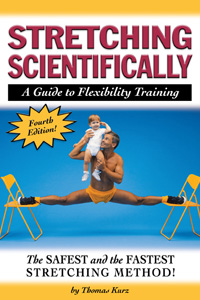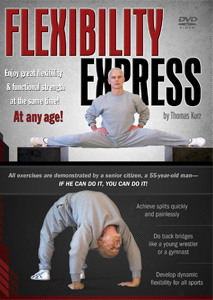by Thomas Kurz
I get many questions from older martial artists on whether it is possible to improve flexibility at an advanced age. I get so many of these questions that I think they should be answered in an article.
Question: I enjoy your articles on fitness and stretching. I use your advice in my martial arts training. I would like to use your video and book to prove that stretching can be achieved at almost any age. My sensei say we are to old to achieve this level of stretching. We are a group of dedicated karate-ka which have been together for 10 years and we train with our regular class and as well we operate a private club. We are a group of 6 people ranging in age from 45 to 53.
I wouldn’t mind hearing your comments on this issue of age and stretching.
Answer: Can you improve your flexibility if you are fifty or sixty years old? Why not? Eighty-year-old people can. How far you can improve in absolute terms, i.e., what range of motion you can achieve, depends on the initial level of your flexibility and strength.
Below are relevant excerpts from the current edition of Stretching Scientifically.
Our method of stretching depends on making your muscles stronger in stretched out positions. It means that you can improve your flexibility as long as you as you can increase your muscular strength. So, if you can make progress lifting more and more weights or overcoming more resistance in any strength exercises, you can stretch more too.
Even elderly men and women over seventy years old can increase their flexibility (Brown et al. 2000; Lazowski et al. 1999). With strength training the elderly, even in their 90s, can increase their strength and muscle mass—not as fast and as much as young people, but they can (Fiatarone et al. 1990; Lexell et al. 1995), and the responsiveness to strength training determines the effectiveness of isometric stretches—the most intense stretches—as long as the structure of the person’s joints is not an obstacle. (Full references are in the book Stretching Scientifically.)
To see if the structure of joints (shape of bones and length of ligaments) permits reaching the extremes of normal range of motion, perform tests such as those in Stretching Scientifically. To see if a given kind of stretches works for you—try them and see. For example, to see if isometric stretches are effective and safe, try them. If contracting a stretched muscle helps to increase the range of motion upon relaxing this muscle, then the isometric stretches are effective. If repeating these stretches every couple or every few days does not cause a persistent muscle soreness, or pain, or weakness—then most likely they are safe. Similar trials can be made with other kinds of stretches. If you can use the isometric stretches, you might be able to make your muscles long and strong enough to support you in a suspended split—even though gains in absolute terms may come more slowly than in the case of young people.
Now that you know why you can stretch effectively well past your 50s just follow the progression of exercises given on the video Flexibility Express and send me photos of you and your colleagues doing splits.
The next question should dispel your doubts and motivate you too.
Question: I have followed the major points of Stretching Scientifically. It was well worth the price. I have achieved the suspended lateral split with a bit of warm up. Gradually getting better, which is okay for a past 60 person. However, the problem is GETTING OUT of the suspended lateral split gracefully! When I am only a few inches off the floor it is not SO awkward looking. When I do it on two chairs I haven’t a clue. I have to use another chair for support. Is there some move or secret to the graceful exit? I have never seen anyone get out of the suspended lateral split when using chairs. I have never seen anyone get out of the suspended lateral split, period. Can you advise?
Answer: I congratulate you for going so strong at over 60! To get out of the hanging side split try a handstand (it can be incomplete, as shown on the video Secrets of Stretching) or just rest your hands on the floor and roll forward. Please remember to send me your photo in the split when you get there.
By the way, a full handstand can be used to get on the chairs too—just as I showed in the old, out of print video Stretching Scientifically. It showed nearly all stretches from the book by the same title. Maybe I should bring it back?
Question: I am 31 years old. Am I too old to be able to do splits?
Answer: You’re old? Get real.
Now a question from the other side of the age spectrum.
Question: I am 15 years old and I am anxious to start isometrics as I know that isometric stretches are the quickest way to achieving splits. I have been very inflexible most of my life and I am starting martial arts (taekwondo). I want to know, from a physiological standpoint, why I can’t do isometrics. I haven’t grown significantly in quite a while. Does this mean I’m ready for more intense training?
Answer: Maybe you can do isometrics and maybe you cannot. It depends on your skeleton’s maturity (whether you have finished growing or not) and your physician should be able to tell you one way or the other. My general recommendation is that young people whose bones are still growing do not do isometric stretches, and it’s based on the advice from world-renowned authorities (see Children and Sports Training and Science of Sports Training).
It is recommended that fifteen- and sixteen-year-olds lift weights no heavier than 100% of their body weight. (The rationale is given in Science of Sports Training.) For a normal adolescent lifting 100% of his or her body weight in common lifts such as the squat, deadlift, or bench press requires much less than the maximal muscular contraction, but in isometric stretches muscles are tensed up to the maximal voluntary contraction. That would exceed the magnitude of tension that is considered safe for an immature skeleton.
Because your sport requires kicking and not doing gymnastic splits, I recommend that you concentrate on dynamic stretches as the main means of developing flexibility and do some relaxed static stretches at the end of a cool-down after your workouts.
Question: Just wanted to say thanks. Got my left split for the first time last week. I got my right split 6 years ago but couldn’t get the last inch down on the left till using your book. I’ll let you know when I get the center split [side split]. I’ve got 3 and a half inches to go. I’m 46, so much for people believing forty is to old to get splits. It provides real incentive when I teach a new 14-year-old cheerleader how to do passive stretches and I’m doing a split and she can’t.
I have a question. High school cheerleaders need to gain usable flexibility as fast as possible. They’re performing the first month and competing about six to eight months later if they begin on a varsity squad instead of junior varsity. What method do you recommend? Dynamic and passive stretching is what I’m teaching at the moment as I’m afraid the isometric stretching will cause permanent injuries. I know you don’t recommend the isometric stretching until the bones have closed. Do you have any other suggestions?
Answer: I suggest normal (i.e, dynamic) resistance exercises through full range of motion. Use light-to-moderate resistance that permits at least 15 repetitions with full control at full range. With low reps (under 30 in this case) do no more than three sets (one or two may suffice). If more reps, then do not do more than two sets. Observe exercisers and let them do only as much as needed and safe.
The above advice is for 14-year-old girls. For recommendations on resistance and exercises (strength, flexibility, endurance, etc.) for boys and girls in this and in other age groups read the book Children and Sports Training.
References
Drabik, J. 1996. Children and Sports Training: How Your Future Champions Should Exercise to Be Healthy, Fit, and Happy. Island Pond, VT: Stadion Publishing Co., Inc.
Kurz, T. 2001. Science of Sports Training: How to Plan and Control Training for Peak Performance. Island Pond, VT: Stadion Publishing Co., Inc.
Kurz, T. 2012. Flexibility Express. Island Pond, VT: Stadion Publishing Company, Inc.
Kurz, T. 2004. Secrets of Stretching: Exercises for the Lower Body. Island Pond, VT: Stadion Publishing Company, Inc.
Kurz, T. 2003. Stretching Scientifically Island Pond, VT: Stadion Publishing Co. Inc.
This article is based on the Stadion books Children and Sports Training: How Your Future Champions Should Exercise to Be Healthy, Fit, and Happy, Science of Sports Training, Stretching Scientifically: A Guide to Flexibility Training and on videos Flexibility Express and Secrets of Stretching. Get these titles now and have all of the info—not just the crumbs! Order now!






Pingback: Age, Gender, and Stretching | Tom Kurz's Weblog
Pingback: A Lazy Friday At Everybodies Gym
am 15 years old but not flexible am too slender i was not become flexible in my life.I want to be flexible i dont know what to do pleas help me to become flexible